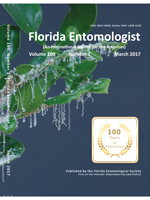The introduced bee species Euglossa dilemma Bembé & Eltz (Hymenoptera: Apidae) continues to spread south and west of its 2003 introduction in Broward County, Florida. This study confirms its presence in Monroe County, and additional new internet records from 2012 to 2016 have found it present in Collier and Lee counties on the west coast of Florida. Soapy water pan traps and blue vane traps were found to be effective in sampling this species, which had previously only been collected with baited traps.
The spread of introduced species into a novel range should be determined by bioclimatic and ecological conditions that are similar to the native range. In 2003, an introduced orchid bee, originally identified as Euglossa viridissima Friese but now known to be Euglossa dilemma Bembé & Eltz (Hymenoptera: Apidae) (Eltz et al. 2011), was found in Broward County, Florida, attracted to baited traps during a fruit fly monitoring survey (Skov & Wiley 2005). By 2004, the species had spread south to adjacent Miami-Dade County (Skov & Wiley 2005; Liu & Pemberton 2009). Subsequent sampling with baited traps found the species occurring northward into Palm Beach County (Pemberton & Wheeler 2006). A modeling approach with bioclimatic data predicted that all of south Florida would be suitable habitat and that the species would likely spread to these areas in the near future with the highest habitat suitability predicted to be in southwestern peninsular Florida (Hinojosa-Díaz et al. 2009).
A 1 d survey of bees in the Flamingo area of Everglades National Park (Monroe County, Florida) was made 12 to 13 Aug 2016, with the 3 following techniques. Fifteen to 30 pan traps, which are 103.5 mL plastic cups painted fluorescent yellow, fluorescent blue, or unpainted white, were placed every 5 m on the ground and filled with soapy water. Colors alternated along the transect, and all traps were pooled within the transect for data analysis. Blue vane traps (SpringStar Inc.) with blue funnels, blue vanes, and yellow 1.8 L jars were hung from native vegetation at 2 m above ground and filled with soapy water. Both pan traps and blue vane traps were left open for 24 h from 9 AM to 9 AM the next day. Sweep netting for 1 h was conducted at 2 locations on open flowers (Bidens pilosa L. [Asteraceae], Phyla nodiflora [L.] Greene [Verbenaceae], Heliotropium curassavicum L. [Boraginaceae]) where bees were active. Bees were identified to species based on keys at Discover Life ( www.discoverlife.org) and comparison to vouchered collections at the Sam Houston State University Natural History Museum, Huntsville, Texas.
Table 1.
Collections of bees from Flamingo area (Monroe County, Florida).

Eight bee species were collected, including 7 native species that had been recorded previously from the Flamingo area of Everglades National Park (Pascarella et al. 2000) and 1 introduced species, E. dilemma, which had not been present during the earlier survey (Tables 1 and 2). The introduced species E. dilemma was collected in both pan traps and blue vane traps but was not observed on the 3 flowering plant species (Table 2). The species was found throughout the collection area indicating that it is widespread in the coastal prairie and disturbed habitats common to this area, but areas of extensive mangrove forests have not yet been surveyed. In addition to this new record from coastal areas of Monroe County, recent records posted to Discover Life (accessed 23 Aug 2016) indicate further spread south in Miami-Dade County and spread into Collier and Lee counties on the west coast of Florida, with records from Biscayne National Park (19 Sep 2012), Naples (20 Oct 2012), and Sanibel Island (23 Sep 2015). As Skov &Wiley (2005) and Hinojosa-Díaz et al. (2009) predicted, the species has effectively colonized the potential range in Florida. As the species is an effective pollinator of both native and non-native plants (Pemberton & Wheeler 2006; Liu & Pemberton 2009), continued research will be needed to determine its ecological impact in various areas. In addition to fruit fly traps and other baited traps that have been shown to be highly effective in sampling this species (Skov & Wiley 2005; Pemberton & Wheeler 2006), this study shows that E. dilemma may be collected using soapy water pan traps and unbaited blue vane traps, which are highly effective in collecting large numbers of individuals and in attracting males.
Table 2.
Collections of Euglossa dilemma bees from sites surrounding Flamingo, Everglades National Park (Monroe County, Florida).

Collections were made under a Scientific Research and Collecting Permit issued by Everglades National Park (study # EVER-00530, accession # EVER-02188). Funding for travel and sampling equipment was provided by the Sam Houston State University College of Science and Engineering Technology.





